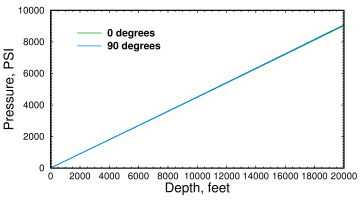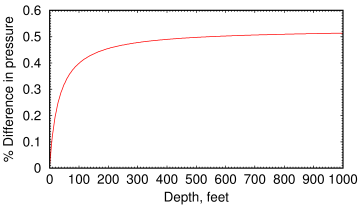 ast week, researchers
recorded a baleen
whale sound from a depth of 1000m (3280 feet) [1] near the Mariana Trench
(not “in” it, as the news media are reporting) which
is 36,198 feet deep[2] and has an estimated pressure of 16,530 psi. It's a dramatic
demonstration of how sound travels in the ocean. But it raises the question: how deep can whales
and submarines actually dive?
ast week, researchers
recorded a baleen
whale sound from a depth of 1000m (3280 feet) [1] near the Mariana Trench
(not “in” it, as the news media are reporting) which
is 36,198 feet deep[2] and has an estimated pressure of 16,530 psi. It's a dramatic
demonstration of how sound travels in the ocean. But it raises the question: how deep can whales
and submarines actually dive?
| Length | Depth | Ratio | Ref | |
|---|---|---|---|---|
| K-3 (627)† | 352 | 1017 | 2.89 | 3 |
| Halibut | 350 | 700 | 2.00 | 4 |
| Nautilus | 322 | 700 | 2.17 | 4 |
| 941 (Typhoon) | 564 | 1300 | 2.30 | 4 |
| U Boat Type XXVIW | 184 | 435 | 2.36 | 4 |
| Los Angeles | 362 | 950 | 2.62 | 4 |
| 955 (Borei) | 557 | 1475 | 2.65 | 4 |
| Thresher | 278 | 1300 | 4.67 | 4 |
| Seawolf | 353 | 1600 | 4.53 | 5,6 |
| 705 (Alfa) | 261 | 1300 | 4.98 | 4 |
| 971 (Akula) | 361 | 1970 | 5.45 | 4,7 |
| 685 (Komsomolets) | 388 | 3280 | 8.45 | 4 |
| Trieste | 59 | 35797 | 607 | |
| Blue whale | 98 | 656 | 6.70 | 8 |
| Bottlenose dolphin | 8 | 1754 | 219.2 | 9 |
| N. elephant seal | 14 | 5013 | 358.1 | 9 |
| Sperm whale | 52 | 9836 | 189.2 | 9 |
| Beluga whale | 18 | 4125 | 229.2 | 10 |
| Calif. sea lion | 7 | 1580 | 225.7 | 9 |
| Human scuba diver | 6 | 660 | 110.0 | |
| Leatherback turtle | 5.7 | 4262 | 747.7 | 9 |
| Blue-eyed cormorant | 2.3 | 410 | 178.3 | 9 |
Animals = Maximum recorded depth.
Length of animals is average adult length.
Units = feet; 1 ft = 0.3048 meter
Data for Virginia class not available
In the movies, submarines are always depicted as if they're far under the surface. In fact, the most advanced submarines in service today can barely dive more than 4½ times their own length. It's scarcely an exaggeration to say that if some older subs were positioned vertically, one end would be out of the water and the other end would be below its safe depth.
The parameter that people care about is test depth, which is a fixed percentage of the maximum depth recommended by the manufacturer. The maximum depth the sub is designed for is called design depth. These specs vary from country to country. The U.S. Navy, for instance, sets the test depth to be 2/3 of design depth. This is essentially a safety standard, so subs from different countries are not directly comparable. And of course, they are conservative estimates; real numbers, especially for crush depth, if they're known at all, are tightly held secrets.
Whale diving depths
Marine creatures can dive to much greater depths in proportion to their lengths than submarines. Schreer & Kovacs[9] documented a sperm whale (Physeter macrocephalus, aka Physeter catodon, a member of suborder Odontoceti, the toothed whales) diving to 3000m (9836 feet) or 189 times its length, though 6000 feet is more typical, while baleen whales (suborder Mysticeti) such as the blue whale can only dive to 200–500m[8]. Scuba divers (length, say 6 feet) can dive up to 660 feet (110 times their length). The beluga whale can dive to 4125 ft, where the pressure is 1850 psi, while a typical WWII U-boat could only tolerate 208 psi.
The Soviet Alfa and Komsomolets submarines, which have titanium hulls, were said to have test depths of 1300 and 3280 feet (4.98 and 8.45 times their length, respectively).
Of course, depth is an engineering trade-off against cost and functional utility such as range, speed, stealth, and safety; while the Nautilus could only dive 2.17 times its own length, the deep submergence vehicle Trieste was able to dive 35,797 feet, or 602 times its own length, but would have been helpless in combat. Risk aversion is another factor; the USN became highly risk-averse after the Thresher.[4]
Ocean sound
Incidentally, differences in the speed of sound with pressure and temperature create a sound channel (technically the Sound Fixing and Ranging or SOFAR channel) where the speed of sound is minimal. In warm waters this is found at about 700–1000m depth. Sound coming from above and below this is refracted into this sound channel.[11] So the whale recording glider at 1000m was at the perfect depth to detect the dwarf minke whale call.
Unmanned Undersea Vehicles
Just as UAVs may someday replace manned aircraft, UUVs are gradually taking over undersea applications. Remotely operated underwater drones, or UUVs (unmanned undersea vehicles), can in principle dive deeper than subs because there's no need to provide a livable atmosphere. Mines are a serious threat to military submarines, so reconnaissance UUVs are used to search for them safely. The AN/SLQ-48 Mine Neutralization Vehicle is said to be able to reach 2000 feet.
As technology improves, our machines become more like living animals. Probably the most amazing underwater item in the Navy, the bio-inspired WANDA-II (Wrasse-inspired Agile Near-shore Deformable-fin Automaton) UUV, named after a tropical fish, is being designed with flapping robotic fins instead of propellers. The Navy says these fins use active curvature control to generate vectored thrust. Unfortunately, the specs on these seem to be classified. Unmanned surface vehicles, called wave gliders, are used to measure salinity and temperature. They're powered by waves and solar energy; some have an onboard computer running Linux. By contrast, Slocum Gliders, like the one the Chinese recently stole, have a 6 foot long pressure hull and can submerge up to 378 times their overall length.
It's not clear why the Chinese would steal one, since they're are publicly available, but they're not cheap: upwards of $150,000.

Ocean pressure vs depth at different latitudes

Ocean pressure is slightly higher at the poles than at the equator, even accounting for temperature
Ocean pressure
Ocean pressure, given by the simple equation P = ρdg + Po, where Po is the atmospheric pressure (14.7 psi), increases by about 15.2 psi for each 10 meters of depth. Of course the relationship is more complex than this, because gravitational acceleration g varies with depth, and density ρ varies with pressure, temperature, and salinity. Surface waves also change the pressure. Many people use the equation from the UNESCO handbook Algorithms For Computation of Fundamental Properties of Seawater. A good discussion of the equation is here. See also here. (Caution: this algorithm goes wonky above about 7,000 atm.)
These pressures may not seem high to chemists; high pressure liquid chromatography (HPLC) is routinely done at up to 15,000 psi, comparable to the pressure at the Mariana Trench. Ultra-high pressure is useful in chemistry because higher pressure means greater ability to separate similar molecules. But these UHPLC columns are small, so a leak just causes a fine spray instead of a flood. Keeping a space large enough to house humans safely is a much greater challenge.
Sources
[1] Niewkirk SL, Fregosi S, Mellinger DK, Klinck H (2016) A complex baleen whale
call recorded in the Mariana Trench Marine National Monument.
J. Acoust. Soc. Am. 140, (2016); doi: 10.1121/1.4962377
The researchers used a hydrophone towed by a Koningsberg Seaglider, which the authors
say repeatedly dove in a sawtooth pattern to 1000m depth and back to the surface at a
horizontal speed of 25 cm/s. They tentatively identified the whale calls, which they
call WPBs or Western Pacific Biotwangs, as dwarf minke whale calls.
[2] www.marianatrench.com/mariana_trench-oceanography.htm
[3] Actual dive; Polmar & Moore, Cold War Submarines. Potomac, 2004
[4] Polmar & Moore, Cold War Submarines. Potomac, 2004
[5] http://www.naval-technology.com/features/feature-the-worlds-biggest-submarines/
[6] Test depths for US subs are secret; unofficial sources vary.
[7] Some confusion about this number; other sources say this is max. operating depth and test depth is 1570 feet for Akula I and 1710 feet for Akula II and III.
[8] Lagerquist, B.A., K.M. Stafford and B.R. Mate. (2000). Dive characteristics of satellite-monitored blue whales (Balaenoptera musculus) off the central California coast. Marine Mammal Science 16(2):375–391. Schreer and Kovaks report a maximum dive of 100m (328 ft) and contrast them with fin whales (which are also in the baleen suborder), which can dive to 500m (1640 ft).
[9] Schreer JF, Kovacs KM (1997). Allometry of diving capacity in air-breathing vertebrates. Can J Zool 75, 338–358
[10] http://stason.org/TULARC/animals/dolphins/2-14-How-deep-can-dolphins-dive.html
[11] Talley LD, Pickard GL, Emery WJ Swift JH (2011). Descriptive Physical Oceanography 6th ed, p.50
Last edited jan 16 2016, 5:31 am

